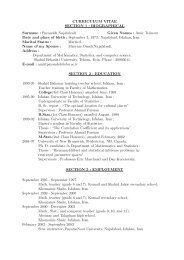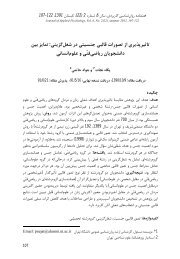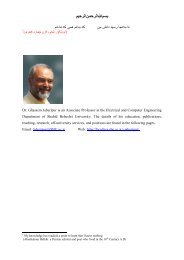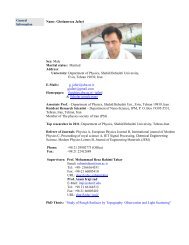A tale of two symmetrical tails - Shahid Beheshti Faculties and PhD ...
A tale of two symmetrical tails - Shahid Beheshti Faculties and PhD ...
A tale of two symmetrical tails - Shahid Beheshti Faculties and PhD ...
- No tags were found...
Create successful ePaper yourself
Turn your PDF publications into a flip-book with our unique Google optimized e-Paper software.
BMC Bioinformatics 2008, 9:274http://www.biomedcentral.com/1471-2105/9/274Conclusion: We suggest that the puzzling abundance <strong>of</strong> palindromic sequences in proteins ismainly due to their frequent concurrence with low-complexity protein regions, rather than a globalrole in the protein function. In addition, palindromic sequences show a relatively high tendency t<strong>of</strong>orm helices, which might play an important role in the evolution <strong>of</strong> proteins that containpalindromes. Moreover, reverse similarity in peptides does not necessarily imply significantstructural similarity. This observation rules out the importance <strong>of</strong> palindromes for forming<strong>symmetrical</strong> structures. Although palindromes frequently overlap with conserved Blocks, wesuggest that palindromes overlap with Blocks only by coincidence, rather than being involved witha certain structural fold or protein domain.BackgroundSymmetry <strong>of</strong> shapes is something that is found everywherein nature. Human beings have always beenattracted to <strong>symmetrical</strong> properties <strong>of</strong> natural phenomena,<strong>and</strong> their interest is reflected in art.Creation <strong>of</strong> <strong>symmetrical</strong> sentences (i.e. "palindromes")goes back to at least 20 centuries ago. The Sator Square [1]contains probably the oldest known palindrome, whichshows the Latin sentence "SATOR AREPO TENET OPERAROTAS". Note that the word "tenet" is a palindrome itself.Since then, many other famous palindromic sentenceshave been constructed in different languages.With the progress <strong>of</strong> molecular biology in the 20th century,a new level <strong>of</strong> symmetry was discovered in nature.From the study <strong>of</strong> restriction endonucleases in the 60's<strong>and</strong> the early 70's [2-5], it became clear that a certain type<strong>of</strong> palindrome, i.e. reverse palindrome, occur in DNAsequences. Restriction enzymes recognition sites whichexist in double-str<strong>and</strong>ed <strong>and</strong> not single str<strong>and</strong>ed DNA, areusually "palindromic". For example:G A A T T CC T T A A Gis an example <strong>of</strong> a palindromic sequence recognized byrestriction enzyme EcoRI. They are usually referred to as"reverse palindromes", because the sequence <strong>and</strong> polarity<strong>of</strong> both str<strong>and</strong>s <strong>of</strong> the DNA molecule define their palindromicnature. Several studies suggest that reverse palindromes(or for simplicity, "palindromes") are statisticallyunder-represented in some genomes [6-10], presumablybecause <strong>of</strong> the existence <strong>of</strong> restriction endonucleases inthe host cells. Palindromic sequences are known to haveroles in DNA replication [11] <strong>and</strong> RNA transcription [12].In proteins, palindromes appear in a polypeptide chain.For example, the hypothetical protein sequence:PQRSRQPis a palindromic sequence. PQR <strong>and</strong> RQP will be referredto as the "sides" <strong>of</strong> this palindrome, while S will be calledthe "linker" (see Methods).Since the original suggestion <strong>of</strong> the existence <strong>of</strong> importantpalindromic sequences in proteins [13-15], or simply"palindromic peptides", relatively little effort has beenmade to find the significance <strong>of</strong> such sequences. Inversesequence similarity <strong>of</strong> proteins is not an exception by anymeans [16,17], <strong>and</strong> some studies suggest that palindromesmay appear in protein sequences more frequentlythan is expected by chance [18,19]. Many have tried t<strong>of</strong>ind a relationship between palindromic sequences <strong>and</strong>protein structure. It has been suggested, directly or indirectly,that palindromic sequences are important for thestructure <strong>and</strong>/or function <strong>of</strong> several classes <strong>of</strong> proteins,including DNA binding proteins [15,18,20], the Rhodopsinfamily <strong>and</strong> ion channels [13], prions [21,22],metal binding proteins [23] <strong>and</strong> receptors [24]. Some syntheticproteins which have structural characteristics asnative proteins, as in the case <strong>of</strong> collagen protein model[25], can be added to this list.In this work, we try to address the question <strong>of</strong> why palindromesare so frequent in proteins <strong>and</strong> to see if they havespecific functions. In addition, we try to find a possiblerelationship between the symmetry <strong>of</strong> the sequence <strong>and</strong>the structure.Results <strong>and</strong> DiscussionLinguistic complexity <strong>of</strong> palindromesOhno, [15] in one <strong>of</strong> his short papers on the importance<strong>of</strong> palindromic sequences in proteins, suggested that H1histone is rich with palindromes only because <strong>of</strong> the highfrequency <strong>of</strong> alanine <strong>and</strong> lysine (48% <strong>of</strong> all residues) in itssequence. In an effort to pursue this proposal, we try totest whether palindromes are a result <strong>of</strong> a biased aminoacid usage, or in other words, a result <strong>of</strong> "low complexity".We use linguistic complexity (LC) as a measure <strong>of</strong> complexity<strong>of</strong> sequence. LC takes values between 0 <strong>and</strong> 1. Thelower the LC value, the lower the complexity <strong>of</strong> thesequence. We compare the distribution <strong>of</strong> LC values inPage 2 <strong>of</strong> 7(page number not for citation purposes)
BMC Bioinformatics 2008, 9:274http://www.biomedcentral.com/1471-2105/9/274real palindromes <strong>and</strong> r<strong>and</strong>omly generated palindromes,as explained in Materials <strong>and</strong> Methods.Table 1 summarizes the results <strong>of</strong> this comparison. TheMann-Whitney test was used to assess the significance <strong>of</strong>differences observed between medians <strong>of</strong> distributions.The results clearly suggest that the linguistic complexity <strong>of</strong>real protein palindromes is significantly lower than whatis observed in r<strong>and</strong>omly constructed palindromes.Palindromic peptides <strong>and</strong> their probable functional rolesPalindromic sequences are known to be present in a variety<strong>of</strong> proteins [14,18], <strong>and</strong> different functions have beenproposed to be associated with them. We tried to findroles <strong>of</strong> palindromic sequences in a systematic way, bycomparing palindromes with conserved sequencesrecorded in the Blocks database [26,27].From our protein dataset <strong>of</strong> 1094 proteins, only 373 containedat least one reported Block. From these proteins, 54Blocks overlapped with palindromic sequences in the correspondingproteins. These Blocks are listed in a file submittedwith this article (see Additional file 1). It wasinteresting to find that a variety <strong>of</strong> functions were possiblyassociated with some palindromic sequences.Figure 1 shows examples <strong>of</strong> Blocks that contain palindromicprotein segments. Conserved palindromes in Figures1A <strong>and</strong> 1B are presumably the result <strong>of</strong> low sequence complexity.As mentioned before, such sequences are prone toproduce palindromes. The Block in Figure 1C clearlyincludes a palindromic consensus. This Block might haveevolved from a palindromic ancestor with serine proteaseactivity. Finally, there are palindromes in conservedBlocks like that in Figure 1D, which seem to be completelyaccidental.Is the symmetry <strong>of</strong> palindromic sequences reflected in theirstructures?Can palindromic protein sequences help in formation <strong>of</strong>structurally <strong>symmetrical</strong> folds? For answering this questionone should test whether symmetry <strong>of</strong> palindromicpeptides is reflected in their structure.While the 3D structure <strong>of</strong> reverse palindromes in doublestr<strong>and</strong>edDNA is <strong>symmetrical</strong>, there is much debate aboutthe structural similarity <strong>of</strong> protein sequences which havereverse similarity. One might expect that reversing thesequence would result in folds that are mirror-images <strong>of</strong>the original fold [28]. However, there exists theoretical<strong>and</strong> experimental evidences that sequence reversingresults in the same rather than the mirror folding, presumablydue to the fact that both native <strong>and</strong> reverse proteinshave the same amino acid compositions <strong>and</strong>/or similarhydrophobic-hydrophilic patterns [23,29,30]. Evidencesuggesting reverse peptide sequences result in differentstructures has also been presented in the literature. Fromanalysis <strong>of</strong> Retro-inverso peptides (reversed peptides consisting<strong>of</strong> D instead <strong>of</strong> L amino acids), it became clear that,with few exceptions [31,32], these peptides behave verysimilarly <strong>and</strong> are even recognized by the same antibodies.Contrary to these, reversed peptides generally behave differently[33-38]. Moreover, many research groups havereported that reversing a sequence can change its fold[39,40], or even extinguish its folding ability [41]. In general,the sequence similarity <strong>of</strong> reverse sequences may notimply a significant structural similarity [17,42].We studied the structural characteristics <strong>of</strong> the <strong>two</strong> sides <strong>of</strong>palindromic sequences. We considered very short peptideswith perfect reverse-similarity in sequence. This conditionassured that differences in structure cannot be dueto differences in sequences. Since we did not allow longlinker sequences between the <strong>two</strong> sides <strong>of</strong> the palindromes,peptide segments coded by the <strong>two</strong> sides are closeTable 1: Comparison <strong>of</strong> the distribution <strong>of</strong> linguistic complexity (LC) values in real vs. r<strong>and</strong>omly generated palindromes.Length(X), Length(Y) Average LC <strong>of</strong> the real set Average LC <strong>of</strong> the r<strong>and</strong>om set Level <strong>of</strong> significance in Mann-Whitney test3,0 0.769 0.841 *3,1 0.805 0.869 **3,2 0.867 0.893 *4,0 0.761 0.869 **4,1 0.831 0.886 **4,2 0.889 0.903 **4,3 0.897 0.913 **5,0 0.628 0.888 **5,1 0.687 0.899 **5,2 0.866 0.911 *5,3 0.828 0.918 **5,4 0.929 0.928 NSFor a definition <strong>of</strong> X <strong>and</strong> Y in a palindrome please see Methods. NS: non-significant difference; *: significant at the level <strong>of</strong> 0.05; **: significant at thelevel <strong>of</strong> 0.01.Page 3 <strong>of</strong> 7(page number not for citation purposes)
BMC Bioinformatics 2008, 9:274http://www.biomedcentral.com/1471-2105/9/274Examples <strong>of</strong> Blocks that contain palindromic peptidesFigure 1Examples <strong>of</strong> Blocks that contain palindromic peptides.The y-axis shows bits <strong>of</strong> information [52] in each position<strong>of</strong> the corresponding palindrome. (A) Blockcorresponding to the palindrome in PDB ID 1tzy chain D; (B)Block corresponding to the palindrome in PDB ID 1a99 chainA; (C) Block corresponding to the palindrome in PDB ID 1agjchain A; <strong>and</strong> (D) Block corresponding to the palindrome inPDB ID 1yz7 chain A.to each other in space <strong>and</strong> therefore, are expected to formtheir fold in a similar environment.If both sides <strong>of</strong> a palindrome appear in the same secondarystructure, they will be considered structurally similar.Therefore, we grouped our palindromes into three classes:palindromes whose both sides have α-helical structure:"all-alpha", palindromes whose both sides have β-sheetstructure: "all-beta", <strong>and</strong> other palindromes: "others".Among the 980 palindromic sequences in our dataset,120 (12.2%) were "all-alpha", 7 (0.7%) were "all-beta",<strong>and</strong> the remaining 853 (87.1%) were classified as "others".Among the 489720 r<strong>and</strong>omly sequences occurring inthe proteins, 16449 (3.4%) were "all-alpha", 2973 (0.6%)were "all-beta", <strong>and</strong> the remaining 470248 (96%) fall into"others" class. The results suggest that palindromes havesignificantly greater tendency to appear in α-helices comparedto r<strong>and</strong>om sequences. There seems to be only aweak preference for palindromic sequences to appear instr<strong>and</strong>s.It is generally accepted that sequences <strong>of</strong> natural proteinsare far from being r<strong>and</strong>om. It has been shown that, unlessamino acid composition is restrained [43] or a binary patterning<strong>of</strong> polar <strong>and</strong> non-polar amino acids is defined[44,45], proteins with r<strong>and</strong>om sequences rarely form secondarystructures [46]. Evidently, decreased amino acidcomposition complexity or binary patterning <strong>of</strong> polar <strong>and</strong>non-polar amino acids increases the chance for palindromeformation. Furthermore, it has been shown thatproteins formed from repeats <strong>of</strong> non-natural peptides <strong>and</strong>palindromic peptides can form secondary structures insolution [47]. Our results suggest that, even compared to(r<strong>and</strong>omly-selected) natural protein fragments, palindromeshave a greater tendency to form at least α-helices,which might be related to their frequent appearance inproteins. This finding might be <strong>of</strong> great importance fordesigning de novo secondary structures. Certainly, all palindromesdo not form helices. It might be interesting toinvestigate other factors that alter the tendency <strong>of</strong> palindromicpeptides to form regular secondary structures likehelices.We also compared the structural similarity (RMSD)between the <strong>two</strong> palindrome sides to the correspondingvalue in a set <strong>of</strong> r<strong>and</strong>omly selected protein fragments.Since a few atoms in the PDB structures <strong>of</strong> r<strong>and</strong>omlyselected fragments were <strong>of</strong>ten missing, we additionallycompared the Cα trace <strong>of</strong> those fragments. For the palindromicsequences, we compared the structures <strong>of</strong> backbones<strong>of</strong> the <strong>two</strong> sides <strong>of</strong> a palindrome, <strong>and</strong> also thestructure <strong>of</strong> the backbone <strong>of</strong> the left side with the structure<strong>of</strong> the backbone <strong>of</strong> mirror image <strong>of</strong> the right side. In eachcase, an RMSD value was calculated to assess structuralsimilarity. In order to see whether this alignment is significantly"good", we compare the RMSD values to the samevalues computed for r<strong>and</strong>omly selected protein fragments<strong>of</strong> the same length. A good structural similarity <strong>of</strong> the <strong>two</strong>sides must result in smaller RMSD values for the palindromesides as compared to r<strong>and</strong>omly selected fragments.Table 2 summarizes the results <strong>of</strong> the comparisons. Onlya small number <strong>of</strong> palindromes showed significantlysmaller RMSD values <strong>and</strong> the average RMSD <strong>of</strong> palindromesis almost in the middle <strong>of</strong> the RMSD values forr<strong>and</strong>om fragments. This implies that the <strong>two</strong> sides <strong>of</strong> apalindrome do not in general show an "exceptional"structural similarity. In other words, reverse similarity atthe sequence level in proteins is not necessarily reflectedat the level <strong>of</strong> structure.We also focused on the short conserved palindromeshown in Figure 1C. The values <strong>of</strong> P for none <strong>of</strong> the fourcomparisons for this palindrome were less than 0.66. Furthermore,the <strong>two</strong> sides <strong>of</strong> this conserved palindromehave different secondary structures. This example confirmsthat the reverse similarity <strong>of</strong> the protein sequence isprobably not reflected in the structure. Altogether, onemay conclude that palindromic peptides can hardly helpin forming <strong>symmetrical</strong> structures in proteins <strong>and</strong> this certainlyis not a reason for their prevalence in proteins.Page 4 <strong>of</strong> 7(page number not for citation purposes)
BMC Bioinformatics 2008, 9:274http://www.biomedcentral.com/1471-2105/9/274ConclusionWe suggest that the puzzling abundance <strong>of</strong> palindromicsequences in proteins is mainly due to their frequent concurrencewith low-complexity protein regions, rather thana global role in the protein function. In addition, palindromicsequences show a relatively high tendency to formhelices, which might play an important role in the evolution<strong>of</strong> proteins that contain palindromes. Moreover,reverse similarity in peptides does not necessarily implysignificant structural similarity. This observation rules outthe importance <strong>of</strong> palindromes for forming <strong>symmetrical</strong>structures.It is not unusual to find palindromes within functionallyconserved protein Blocks. However, the conserved Blockshave very different functions, which suggest that palindromesoverlap with Blocks only by coincidence, ratherthan being involved with a certain structural fold ordomain. In addition, many <strong>of</strong> the conserved patterns arenot "<strong>symmetrical</strong>", which confirms that Blocks <strong>and</strong> proteinpalindromes overlap accidentally.MethodsDatasetWe obtained sequences for all the proteins in the ProteinData Bank, PDB [48] in FASTA format (30 December2006). This dataset contained 38224 proteins. Using thePISCES culling server [49,50], the sequence dataset wasfiltered to obtain sequences with mutual similarity <strong>of</strong> lessthan 30%, with structure resolution
BMC Bioinformatics 2008, 9:274http://www.biomedcentral.com/1471-2105/9/274mic sequences. Therefore, for a palindrome family such asXYX R , with certain values for |X| <strong>and</strong> |Y|, we constructed10000 r<strong>and</strong>om palindromes. For each r<strong>and</strong>om palindrome,<strong>two</strong> r<strong>and</strong>om sequences with lengths |X| <strong>and</strong> |Y|were constructed, based on the average frequencies <strong>of</strong> thetwenty amino acids in our dataset. The sequences werejoined to create X+Y+X R . Finally, the LC distribution <strong>of</strong>real palindromes was compared to the LC distribution <strong>of</strong>r<strong>and</strong>omly generated palindromes.Finding overlaps between palindromes <strong>and</strong> functional sitesTo investigate possible overlaps between conserved Blocks[26,27] <strong>and</strong> palindromic sequences, we first tried to identifyknown Blocks <strong>of</strong> proteins in our dataset. If Blocks werefound, we then determined whether the palindromes inthe protein fall within the Blocks (or alternatively, theBlocks fall within any <strong>of</strong> the palindromes).In order to visualize Blocks <strong>and</strong> get an overview <strong>of</strong> theirconservation, WebLogo [52] was used to construct graphicalrepresentations <strong>of</strong> the patterns.Analysis <strong>of</strong> three dimensional structures <strong>of</strong> palindromicpeptidesIt is rational to assume that protein segments with thesame secondary structures may show greater structuralsimilarity, regardless <strong>of</strong> their sequence similarity. Therefore,for the analysis <strong>of</strong> 3D structure <strong>of</strong> palindromicsequences, we first determined the secondary structure <strong>of</strong>palindromic segments using DSSP s<strong>of</strong>tware [53]. Then,based on secondary structure data, we categorized palindromesinto "all-alpha" (where the whole structure was inα-helix), "all-beta" (where the whole structure was in β-sheet), <strong>and</strong> "others". Finally, we compared the structuralcoordinates <strong>of</strong> each palindromic peptide with a set <strong>of</strong> r<strong>and</strong>omlyselected peptides in the same category.Some reports suggest that reversing the sequence willresult in the same protein fold [23,29,30]. To test this, wecompared the conformation <strong>of</strong> backbone atoms in the<strong>two</strong> palindrome sides. It has also been suggested thatreversing the sequence can result in a structure which isthe mirror image <strong>of</strong> the original structure [28]. Therefore,we additionally compared the backbone <strong>of</strong> one palindromeside with the mirror image <strong>of</strong> the other side. Both<strong>of</strong> these comparisons were performed for all backboneatoms <strong>and</strong> for their Cα traces.For each comparison an RMSD value was calculated. Inorder to see whether there was a significantly small value,from each protein in the dataset we chose 10 r<strong>and</strong>om fragments<strong>of</strong> the same length (i.e. with the length <strong>of</strong> 2|X|+|Y|)<strong>and</strong> considered the first |X| amino acids as the left side <strong>of</strong>the "pseudo-palindrome" <strong>and</strong> the last |X| amino acids asthe right side, <strong>and</strong> then the structural comparison was performed.If the RMSD for structural alignment <strong>of</strong> the <strong>two</strong>palindrome sides is small (i.e. the <strong>two</strong> sides were structurallysimilar), then only a small fraction, say P, <strong>of</strong> r<strong>and</strong>omlyselected fragments will show a smaller value.Statistical analysisWe used Mann-Whitney test for testing the significance <strong>of</strong>differences between medians <strong>of</strong> distributions. This test isuseful when the <strong>two</strong> distributions are skewed <strong>and</strong> cannotbe approximated by a normal distribution [54].AbbreviationsLC: linguistic complexity; RMSD: Root mean square deviation;PDB: Protein Data Bank.Authors' contributionsS–AM presented the original idea. S–AM, MS, HP, CE <strong>and</strong>AK participated in the design <strong>of</strong> the methods <strong>and</strong> led theproject. AS, MK, AK <strong>and</strong> SA implemented the methods.The manuscript was drafted by S–AM. All authors contributedto the discussions for the improvement <strong>of</strong> the originaldraft <strong>and</strong> approved the final manuscript.Additional materialAdditional file 1Conserved Blocks that overlap with palindromes in proteins.Click here for file[http://www.biomedcentral.com/content/supplementary/1471-2105-9-274-S1.zip]AcknowledgementsThis work was in part supported by a grant from IPM (No. CS1385-1-02).References1. Griffiths JG: 'Arepo' in the Magic 'Sator' Square. The ClassicalRev 1971, 21:6-8.2. Danna K, Nathans D: Specific cleavage <strong>of</strong> simian virus 40 DNAby restriction endonuclease <strong>of</strong> Hemophilus influenzae. ProcNatl Acad Sci USA 1971, 68:2913-2917.3. Ford E, Boyer HW: Degradation <strong>of</strong> enteric bacterial deoxyribonucleicacid by the Escherichia coli B restriction endonuclease.J Bacteriol 1970, 104:594-595.4. Roull<strong>and</strong>-Dussoix D, Boyer HW: The Escherichia coli B restrictionendonuclease. Biochim Biophys Acta 1969, 195:219-229.5. Yuan R, Meselson M: A specific complex between a restrictionendonuclease <strong>and</strong> its DNA substrate. Proc Natl Acad Sci USA1970, 65:357-362.6. Burge C, Campbell AM, Karlin S: Over- <strong>and</strong> under-representation<strong>of</strong> short oligonucleotides in DNA sequences. Proc NatlAcad Sci USA 1992 , 89:1358-1362.7. Fuglsang A: Distribution <strong>of</strong> potential type II restriction sites(palindromes) in prokaryotes. Biochem Biophys Res Commun2003, 310:280-285.8. Fuglsang A: The relationship between palindrome avoidance<strong>and</strong> intragenic codon usage variations: a Monte Carlo study.Biochem Biophys Res Commun 2004, 316:755-762.9. Gelf<strong>and</strong> MS, Koonin EV: Avoidance <strong>of</strong> palindromic words in bacterial<strong>and</strong> archaeal genomes: a close connection with restrictionenzymes. Nucleic Acids Res 1997, 25:2430-2439.Page 6 <strong>of</strong> 7(page number not for citation purposes)
BMC Bioinformatics 2008, 9:274http://www.biomedcentral.com/1471-2105/9/27410. Lisnic B, Svetec IK, Saric H, Nikolic I, Zgaga Z: Palindrome content<strong>of</strong> the yeast Saccharomyces cerevisiae genome. Curr Genetics2005, 47:289-297.11. Willw<strong>and</strong> K, Mumtsidu E, Kuntz-Simon G, Rommelaere J: Initiation<strong>of</strong> DNA replication at palindromic telomeres is mediated bya duplex-to-hairpin transition induced by the minute virus <strong>of</strong>mice nonstructural protein NS1. J Biol Chem 1998,273:1165-1174.12. Chu WM, Ballard RE, Schmid CW: Palindromic sequences precedingthe terminator increase polymerase III templateactivity. Nucleic Acids Res 1997, 25:2077-2082.13. Ohno S: Intrinsic evolution <strong>of</strong> proteins. The role <strong>of</strong> peptidicpalindromes. Rivista di Biologia - Biology Forum 1990, 83:287-291.14. Ohno S: Of palindromes <strong>and</strong> peptides. Human Genetics 1992,90:342-345.15. Ohno S: A song in praise <strong>of</strong> peptide palindromes. Leukemia1993, 7:S157-S159.16. Nielsen ML, Savitski MM, Zubarev RA: Improving protein identificationusing complementary fragmentation techniques inFourier transform mass spectrometry. Mol Cell Proteomics2005, 4:835-845.17. Preißner R, Goede A, Michalski E, Frömmel C: Inverse sequencesimilarity in proteins <strong>and</strong> its relation to the three-dimensionalfold. FEBS Lett 1997, 414:425-429.18. Giel-Pietraszuk M, H<strong>of</strong>fmann M, Dolecka S, Rychlewski J, BarciszewskiJ: Palindromes in proteins. J Protein Chem 2003, 22:109-113.19. H<strong>of</strong>fmann M, Rychlewski J: Searching for palindromic sequencesin primary structure <strong>of</strong> proteins. Comput Methods Sci Tech 1999,5:21-24.20. Suzuki M: DNA-bridging by a palindromic α-Helix. Proc NatlAcad Sci USA 1992, 89:8726-8730.21. Kazim AL: Identification <strong>of</strong> putative internalization signals inprion proteins. FEBS Lett 1993, 331:1-3.22. Alderfer JL, Kazim AL, Sulkowski E, Tabaczynski W, Tomasi TB: Aromaticpalindrome peptide <strong>of</strong> prion proteins - A conformationalstudy. FASEB J 1993, 7:A1283.23. Pan PK, Zheng ZF, Lyu PC, Huang PC: Why reversing thesequence <strong>of</strong> the a domain <strong>of</strong> human metallothionein-2 doesnot change its metal-binding <strong>and</strong> folding characteristics. EurJ Biochem 1999, 266:33-39.24. Jaseja M, Mergen L, Gillette K, Forbes K, Sehgal I, Copié V: Structure-functionstudies <strong>of</strong> the functional <strong>and</strong> binding epitope <strong>of</strong>the human 37 kDa laminin receptor precursor protein. J PeptideRes 2005, 66:9-18.25. Stetefeld J, Frank S, Jenny M, Schulthess T, Kammerer RA, Boudko S,L<strong>and</strong>wehr R, Okuyama K, Engel J: Collagen stabilization atatomic level: Crystal structure <strong>of</strong> designed (GlyProPro)10foldon. Structure 2003, 11:339-346.26. Henik<strong>of</strong>f JG, Greene EA, Pietrokovski S, Henik<strong>of</strong>f S: Increased coverage<strong>of</strong> protein families with the blocks database servers.Nucleic Acids Res 2000, 28:228-230.27. Henik<strong>of</strong>f S, Henik<strong>of</strong>f JG, Pietrokovski S: Blocks+: A non-redundantdatabase <strong>of</strong> protein alignment blocks dervied from multiplecompilations. Bioinformatics 1999, 15:471-479.28. Guptasarma P: Reversal <strong>of</strong> peptide backbone direction mayresult in the mirroring <strong>of</strong> protein structure. FEBS Lett 1992,310:205-210.29. Olszewski KA, Kolinski A, Skolnick J: Does a backwardly readprotein sequence have a unique native state? Protein Eng 1996,9:5-14.30. Cheley S, Braha O, Lu X, Conlan S, Bayley H: A functional proteinpore with a 'retro' transmembrane domain. Protein Sci 1999,8:1257-1267.31. Rai J: Retroinverso mimetics <strong>of</strong> S peptide. Chem Biol Drug Des2007, 70:552-556.32. Pal-Bhowmick I, Pati P<strong>and</strong>ey R, Jarori GK, Kar S, Sahal D: Structural<strong>and</strong> functional studies on Ribonuclease S, retro S <strong>and</strong> retroinversoS peptides. Biochem Biophys Res Commun 2007,364:608-613.33. Benkirane N, Guichard G, Van Regenmortel MHV, Bri<strong>and</strong> JP, MullerS: Cross-reactivity <strong>of</strong> antibodies to retro-inverso peptidomimeticswith the parent protein histone H3 <strong>and</strong> chromatincore particle: Specificity <strong>and</strong> kinetic rate-constant measurements.J Biol Chem 1995, 270:11921-11926.34. Guichard G, Benkirane N, Zeder-Lutz G, Van Regenmortel MHV, Bri<strong>and</strong>JP, Muller S: Antigenic mimicry <strong>of</strong> natural L-peptides withretro-inverso- peptidomimetics. Proc Natl Acad Sci USA 1994,91:9765-9769.35. Nieddu E, Melchiori A, Pescarolo MP, Bagnasco L, Biasotti B, LicheriB, Malacarne D, Parodi S: Sequence specific peptidomimeticmolecules inhibitors <strong>of</strong> a protein-protein interaction at thehelix 1 level <strong>of</strong> c-Myc. FASEB J 2005, 19:632-634.36. Phan-Chan-Du A, Petit MC, Guichard G, Bri<strong>and</strong> JP, Muller S, CungMT: Structure <strong>of</strong> antibody-bound peptides <strong>and</strong> retro-inversoanalogues. A transferred nuclear overhauser effect spectroscopy<strong>and</strong> molecular dynamics approach. Biochemistry 2001, 40:5720-5727.37. Sakurai K, Hak SC, Kahne D: Use <strong>of</strong> a retroinverso p53 peptideas an inhibitor <strong>of</strong> MDM2. J Am Chem Soc 2004, 126:16288-16289.38. Verdoliva A, Ruvo M, Cassani G, Fassina G: Topological mimicry<strong>of</strong> cross-reacting enantiomeric peptide antigens. J Biol Chem1995, 270:30422-30427.39. Shukla A, Raje M, Guptasarma P: A backbone-reversed form <strong>of</strong>an all-β α-crystallin domain from a small heat-shock protein(retro-HSP12.6) Folds <strong>and</strong> assembles into structured multimers.J Biol Chem 2003, 278:26505-26510.40. Mittl PRE, Deillon C, Sargent D, Liu N, Klauser S, Thomas RM, GutteB, Grutter MG: The retro-GCN4 leucine zipper sequenceforms a stable three-dimensional structure. Proc Natl Acad SciUSA 2000, 97:2562-2566.41. Lacroix E, Viguera AR, Serrano L: Reading protein sequencesbackward. Fold Des 1998, 3:79-85.42. Lorenzen S, Gille C, Preissner R, Frömmel C: Inverse sequencesimilarity <strong>of</strong> proteins does not imply structural similarity.FEBS Lett 2003, 545:105-109.43. Davidson AR, Lumb KJ, Sauer RT: Cooperatively folded proteinsin r<strong>and</strong>om sequence libraries. Nature Struct Biol 1995, 2:856-864.44. Kamtekar S, Schiffer JM, Xiong H, Babik JM, Hecht MH: Proteindesign by binary patterning <strong>of</strong> polar <strong>and</strong> nonpolar aminoacids. Science 1993, 262:1680-1685.45. Roy S, Ratnaswamy G, Boice JA, Fairman R, McLendon G, Hecht MH:A protein designed by binary patterning <strong>of</strong> polar <strong>and</strong> nonpolaramino acids displays native-like properties. J Am Chem Soc1997, 119:5302 -55306.46. Yamauchi A, Yomo T, Tanaka F, Prijambada ID, Ohhashi S, YamamotoK, Shima Y, Ogasahara K, Yutani K, Kataoka M, Urabe I: Characterization<strong>of</strong> soluble artificial proteins with r<strong>and</strong>om sequences.FEBS Lett 1998, 421:147-151.47. Shiba K, Takahashi Y, Noda T: On the role <strong>of</strong> periodism in theorigin <strong>of</strong> proteins. J Mol Biol 2002, 320:833-840.48. Deshp<strong>and</strong>e N, Addess KJ, Bluhm WF, Merino-Ott JC, Townsend-Merino W, Zhang Q, Knezevich C, Xie L, Chen L, Feng Z, Green RK,Flippen-Anderson JL, Westbrook J, Berman HM, Bourne PE: TheRCSB Protein Data Bank: a redesigned query system <strong>and</strong>relational database based on the mmCIF schema. NucleicAcids Res 2005, 33:D233-D237.49. Wang GL, Dunbrack Jr. RL: PISCES. A protein sequence cullingserver. Bioinformatics 2003, 19:1589-1591.50. Wang GL, Dunbrack Jr. RL: PISCES: recent improvements to aPDB sequence culling server . Nucleic Acids Res 2005,33:W94-W98.51. Troyanskaya OG, Arbell O, Koren Y, L<strong>and</strong>au GM, Bolshoy A:Sequence complexity pr<strong>of</strong>iles <strong>of</strong> prokaryotic genomicsequences: a fast algorithm for calculating linguistic complexity.Bioinformatics 2002, 18:679-688.52. Crooks GE, Hon G, Ch<strong>and</strong>onia JM, Brenner SE: WebLogo: Asequence logo generator. Genome Res 2004, 14:1188-1190.53. Kabsch W, S<strong>and</strong>er C: Dictionary <strong>of</strong> protein secondary structure:pattern recognition <strong>of</strong> hydrogen-bonded <strong>and</strong> geometricalfeatures. Biopolymers 1983, 22:2577-2637.54. Conover WJ: Practical Nonparametric Statistics. 2nd edition.N.Y., John Wiley & Sons; 2006.Page 7 <strong>of</strong> 7(page number not for citation purposes)


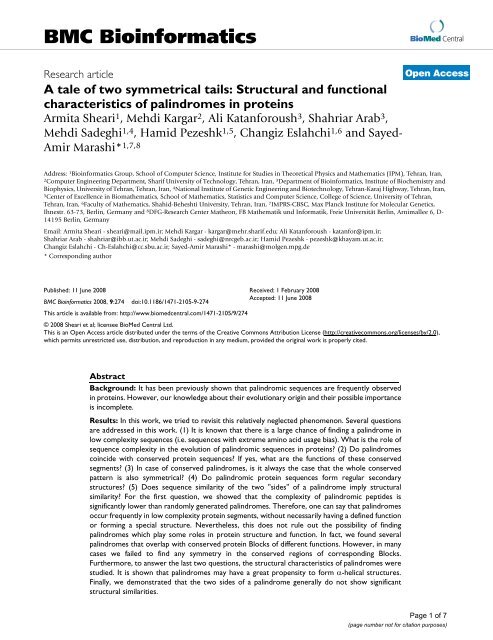



![out= randsrc(m,n,[alphabet; prob]) - Shahid Beheshti Faculties and ...](https://img.yumpu.com/40488921/1/184x260/out-randsrcmnalphabet-prob-shahid-beheshti-faculties-and-.jpg?quality=85)
